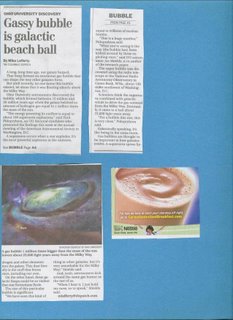A Nebulous Religion

Too bad we can't blow up this gaseous article and read it more easily, but I have the paper copy in front of me. According to the report out of Ohio University, there is a big, whomper, gas bubble only 23,000 light years from here. Lo and behold, though nobody was there to see it form, the experts insist it formed from ten-million to thirty-million years ago from something called a supernova, the explosion of a star. Although we weren't there to see this happen either, it is interesting to see the extrapolation done by old-earth theorists. They say the explosion equaled an amount of hydrogen equal to one million times the mass of the same sun we see a few times in our winters here in Ohio. It equaled trillions of our nuclear bombs.
Astounding! Incredible! They say our galaxy burped.
An OU doctoral student recently presented these findings to the American Astronomical Society meeting in Washington, D.C.
All this, so far, means that at some point after God created everything that is, science tells us about a great cataclysm in outer space. We are sort of used to this. It fits into the second law of thermodynamics which states that everything is decaying (losing heat, exploding, growing more simple, wearing away, growing feeble, dying, turning back into dust, losing our minds, mutating, and so on. Some scientists won't trouble themselves to travel around the globe and examine the consistent evidence from Noah's flood, but they get prickles of the scalp to see a monstrous gas bubble (if we can trust them) 23,000 X 186,000 X the number of seconds in a year away off somewhere in the universe. That is quite a number.
Of course, we are at the mercy of scientists who see tiny things through multi-million dollar instruments. We get the representation in the press, in magazines, or on the web. That carnation instant drink sort of makes a nice spiral, doesn't it? Cut out the caption and the girl in the way and we could palm off a cocoa-colored gas bubble on unsuspecting folks. We'll tell them it came from Willy Wonka's Chocolate Factory and they have the winning ticket to fly across the galaxy and see it. The point is, the age of the bubble is a religious statement since ungrounded in evidence. No-one can even go back a thousand years and state what the universe was like, how big it was, how fast exactly the speed of light was, or whether God created the whole thing with the semblance of age (just as he did Adam and Eve). Oh, the numbers look good to other evolutionist believers, but where is the proof? None. Just big numbers. Supposing a city clerk told the city leaders they had somewhere between ten-million and thirty-million dollars in the treasury at the present time? Hey, somebody is going to audit the books. Well, we should not accept just any numbers thrown out by people who weren't there. I'll bank on God. He has no real competition, just some weak protests from fantasyland.
Supposing we did trust the visual "evidence" that this blue thing is a big old cloud of hydrogen gas and debris, and that the little white dot to the left is our sun-- but we remain leery of the big numbers padding the whole story? There is still a major problem with the article. Who has seen a cloud like this one turn into a solid heavenly body such as a star or a planet(It actually looks much like a button on grandma's blue wool overcoat)? The evolutionists' answer is obvious when we present this nice knockdown argument: They'll say, "You'd just have to hang around a few million or billion years doing time-lapse photography to see a star or a galaxy form from such a gas bubble." Aaargh! Don't hold your breath, my evolutionist friends. It seems like yours would be the first religion to take the job.
Levity aside, the article states, "Gas bubbles are thought to be important in how galaxies evolve . . . . The same paragraph ends with "This dust literally is the stuff that forms stars, including our own! It starts honest enough. Almost looks like a theory a scientist could research, then turns into the same old foundationless hype. No! Let's make that stronger. Some have learned to love a lie.

0 Comments:
Post a Comment
<< Home